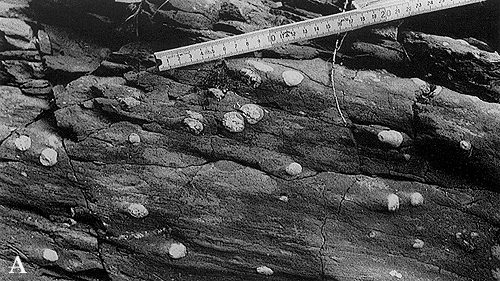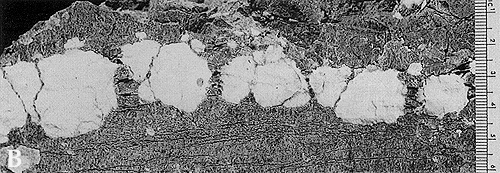

Nodular structure: isolated nodules
Plate 170


Nodular structure: isolated nodules
Plate 170
The white specks in these images are nodules, i.e., aggregates of small crystals precipitated within a sediment permeated by fluids. The interstitial fluids do no consist of water only but also of air and/or biogenic gases; neither is the water pure, but contains various ions, or salts, in solution. In plate 170 A, for example, the nodules are made of calcium carbonate, in B of calcium sulfate (anhydrite). In both cases, the host sediment is continental (alluvial) and has a red color. In humid climates, the topmost part of these deposits, exposed to the atmosphere, is pedogenized, or transformed into soil, with the cooperation of water and various organisms. In drier conditions, pedogenic processes cannot proceed in the usual way; only some physical and chemical modifications can occur.
Among them, the dissolution and reprecipitation of soluble substances when water is available (which happens for short periods). In this respect, the formation of nodules and crusts represents rather a form of diagenesis (vadose diagenesis ) than of pedogenesis. The strong evaporation of arid and semiarid climates "pumps up" water that infiltrated underground during rainstorms; the water is forced upward by capillarity, and salts separate from it. The precipitation of carbonate is favored not only by evaporation but also by the alkalinity of the solu-tion (acid substances are lacking). The carbonate crusts that form just below the topographic surface are called caliche, calcrete, kankar, etc., in different regions of the world. They must not be confused with ordinary beds, i.e., primary deposits. The red color of the sediment is related to oxidation of iron.
Sulfate nodules and crusts indicate extreme aridity, as the mineral is evaporitic; they form in environments known as sabkhas. Inland sabkhas are located in the subbottom of ephemeral (playa ) lakes, coastal sabkhas in barren, salt-encrusted flats exposed to the sea.
Both the carbonate and the sulfate in the nodules shown here are almost pure, as indicated by their white color. This means that the growth of nodules was "displacive": the particles of the host sediment were not accepted inside the structure, but pushed aside. The nodules had, originally, a porous texture, which was subsequently occluded by the hydration of anhydrite into gypsum. Morphology and size of the nodules did not change when gypsum replaced anhydrite.
In conclusion, nodular structures related to vadose diagenesis are paleoclimatic indicators pointing to emergent and semiarid or arid conditions. They should not be confused with nodules of other origins (compare with plates 169 and 176).
| Photos: A G. G. Ori 1992; B A. Bosellini 1992. |